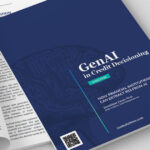Are you taking advantage of the flexibility that comes with composable architecture? In the dynamic landscape of modern technology, organizations are faced with the decision of transitioning from legacy systems to more adaptable frameworks. A prominent contender in this shift is composable architecture – an approach that empowers businesses to better adapt to both internal and external needs.

What is Composable Architecture?
Composable architecture refers to a modern design approach where the components of a system can be easily assembled or reassembled to meet specific business needs. It involves breaking down complex systems into modular, interchangeable components to allow for increased flexibility, scalability, and agility for organizations operating within a dynamic environment.
Each component serves a specific purpose and can be developed and maintained independently. Components and modules within composable architecture are designed to work together seamlessly and can be deployed in various configurations, working together to perform a specific task (or set of tasks).
Components can then be re-used in different parts of the system, increasing efficiency and reducing time spent duplicating development efforts. System maintenance is also simplified since updates can be applied to specific components instead of the entire system.
Key Elements of Composable Architecture
Modularity
Interoperability
Flexibility
Scalability
Agility
Reusability
Who can Benefit from Composable Architecture?
Composable architecture is industry-agnostic, meaning your organization stands to benefit from it whether based in finance, healthcare, hospitality, e-commerce, telecommunications, or another industry entirely.
Take e-commerce giants like Amazon, for example. Amazon utilizes composable architecture to power its e-commerce platform, allowing for the rapid addition of new products and services and the ability to scale quickly.
Financial institutions may use composable architecture to adapt to changes in the market, integrate new technologies, and facilitate a more customer-focused approach through increased personalization.
Meanwhile, an organization in the healthcare industry may leverage composable architecture to make information such as credentialing status, health records, diagnostic data and more readily available to the proper departments.
What are the Benefits of Composable Architecture?
Predicting future customer expectations is challenging – especially when their needs are constantly changing. Having a robust, intelligent, and efficient system with minimal downtime and solid security is crucial.
Composable architecture addresses numerous challenges of legacy systems, including:
- Rigid and long development times
- Higher costs associated with delivery and maintenance
- Restrictions to data and technology partners
- Insufficient and limited support availability
- Negative impacts to the customer experience
Composable architecture can aid in increasing the productivity of developers and reducing technical debt within a short span of time, a growing problem of many legacy systems. This also plays a key role in ensuring that systems across the organization interact with each other effectively and efficiently.
Developing a composable approach also allows for multi-faceted initiatives that support broad business objectives. For this reason, Zoot often works with clients to highlight one or two areas of opportunity ripe for an immediate ROI in terms of both customer experience and operational efficiency.
Other benefits of composable architecture include:
- Various build and licensing models
- Access to, and effective management of, large amounts of data
- Robust API standardization and management
- Strong system integration capabilities with an enterprise view
- Greater transparency, centralized documentation, and enhanced risk controls through a partner ecosystem model with full auditability
What are the Drawbacks of Composable Architecture?
While the benefits of composable architecture are significant, there can be some growing pains as organizations adapt and move away from legacy systems. Businesses must be aware of these challenges from the beginning in order to address them strategically throughout the development process.
Interoperability problems (difficulties in getting the components to work together as intended) are common culprits. Integrating various components with different functionality within one system may pose difficulties in ensuring seamless interaction.
The flexibility of the system, while extremely beneficial long-term, also results in a need for more rigorous testing to ensure components are behaving as expected across a wide variety of scenarios, which can take valuable time and resources.

There are a multitude of factors that determine the success of a composable architecture platform, starting with the selection of the right partner – one that will facilitate how the entire system is brought together to deliver a holistic environment resulting in exceptional experiences for internal users and customers alike.
When you partner with Zoot, your organization can foster an environment where systems can be independent yet well integrated by reaping the benefits of a modern composable architecture approach.
Zoot’s proprietary tool, WebRules® Builder, provides the flexibility to independently develop and implement rules, logic, and workflows by pulling in components from a central location. Users are then able to manage and make updates that directly align with specific requirements, as well as respond more quickly to changing customer needs.
Zoot prioritizes integration readiness and flexibility, allowing organizations to dramatically increase the speed at which they can onboard new partners or design, build, test, and deploy products and services. This is key for value-driven business transformations aiming to drive growth while setting up a flexible and cost-effective IT landscape. Plus, our team is here to provide fast support should you run into any issues.
Composable Solutions
- Modular build models
- Enterprise architecture view and intergration capabilities
- Large amounts of data access and management
- Robust API management
- Greater transparency, enhanced risk controls and auditability
Legacy Solutions
- Ridgid and long development times
- Higher costs associated with delivery and maintenance
- Restrictions to data and technology partners
- Insufficient and limited support skills for legacy technology
- Impacts the custorer experience negatively
The Path to Success
The adoption of composable architecture has emerged as a strategic gold mine for organizations seeking to become increasingly flexible and scalable in today’s ever-evolving business landscape. A wide range of benefits, from increased productivity and reduced technical debt to enhanced system integration capabilities, showcase the transformative power of this approach.
The path to success lies in thoughtful implementation with the right partner in your corner. Embrace the future of architecture with a composable solution, and unlock a new era of innovation and efficiency.
How would a system built on composable architecture open avenues of growth for your organization?




